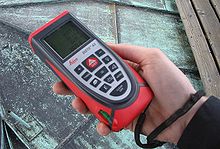Distancing

A spacer (also Disto , Distometer , LaserDisto , Distomat ) is a device for electro-optical distance measurement . There are handheld devices for simple surveying work in the trade or devices that are placed on theodolites (weight approx. 0.2 to 0.5 kg). In modern total stations these are usually already built in in miniature form. They are used in building surveying and geodesy .
technology
Distanceers are largely based on the time of flight measurement or the measurement of phase shifts of infrared or light waves and can measure distances of up to several 100 m to the nearest cm. To avoid ambiguous solutions, different pulse repetition frequencies are used in one measurement (coarse measurement and fine measurement). Convenient device designs can calculate areas and volumes from the measured values or save the results with attributive information for later evaluation. There are also devices with automatic data transfer via USB or Bluetooth .
More complex instruments achieve this accuracy even over several kilometers if so-called prism reflectors are used at the target point. For lower accuracy there are devices for which reflective foils are sufficient for medium distances, and for close proximity even the diffuse reflex e.g. B. a house wall.
Geometrically, the distance measurements are to be treated as inclined sections, which require the measurement of their inclination or the elevation angle for their conversion into horizontal sections .
Historical
The first practical, but still quite voluminous, spacers came on the market between 1963 and 1972. Instead of working with light, they still work with microwaves and 20–50 cm large parabolic antennas , for example the DI50 and 60 devices from the manufacturer Wild Heerbrugg .
In the 1970s, distance measurement with light and infrared lasers prevailed. Initially, the spacers were still their own measuring units that had to be placed on the tripod instead of the theodolite and were therefore only used for longer (rarely measured) distances. The Wild Distomat series was one of the most popular devices , while Kern Aarau built the smallest and most precise devices, including a. the meometer.
Individual evidence
- ↑ a b Which measuring principle does the DISTO use? Leica Geosystems, accessed October 10, 2013 .